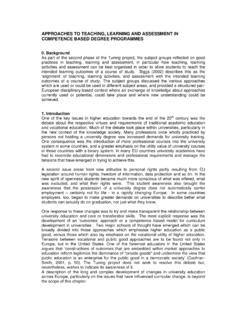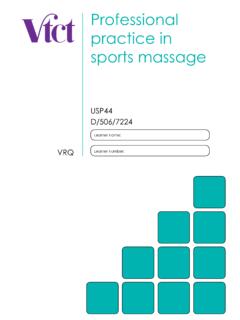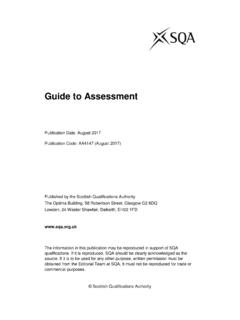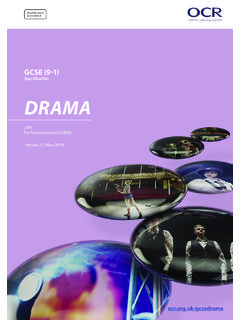Transcription of APPROACHES TO TEACHING, LEARNING AND …
1 APPROACHES TO teaching , LEARNING AND ASSESSMENT AND THE SUBJECT AREA COMPETENCES NURSING Good teaching means that Faculty, as scholars, are also learners Boyer 1990:23-4 There is a well established knowledge and evidence base associated with the LEARNING , teaching and assessment of nursing and nurses: some illustrative texts are outlined at the end of this paper. Boyer s scholarship typology can be aptly applied to nursing in so far as he considers four types of scholarship: that of discovery/research, integration, application/service and that of teaching itself.
2 Nurse learners, whether before or after qualification, are by definition adult learners undertaking an academic, professional/vocational programme of studies that includes both theoretical and practical knowledge, behaviours and attitudes and the ability to perform in routine and unpredictable situations. The pedagogical knowledge base includes concepts and research associated with andragogy, experiential LEARNING , work based LEARNING , organisational cultures and LEARNING , decision making, development of leadership skills, social psychology of LEARNING , values, ethical and emotional literacy to name but a few.
3 The different APPROACHES to LEARNING have all been included in the history of curriculum design and implementation, for example cognitive, behavioural, constructivist and post modern APPROACHES to nursing and nurse education. Theories of competence acquisition, clinical decision making, mentorship, expert practice (Benner), tacit knowledge (Polanyi) and reflection (Schon, Johns, Gibbs) are well established. Theories or models that have been applied to nursing include Bloom s cognitive taxonomy of LEARNING , Steinaker and Bell s experiential taxonomy; Dreyfus and Dreyfus and Benner s work on novice to expert development.
4 There is an increasing emphasis on collaborative LEARNING styles, especially at second cycle level. With at least fifty per cent of the registration programme being practice based, understanding and applying the evidence based of how students learn and develop in practice is crucial. A typical developmental model is that of Benner outlined in Box 1. Box 1 Benner 1984. Novice to a developmental model Benner conducted research using the Dreyfus Model (1981) which posits that the acquisition and development of a skill a student passes through 5 levels of proficiency novice advanced beginner competent proficient, expert These stages reflect changes in 3 general aspects of skill performance (1) Movement from the reliance on abstract principles to the use of past concrete experience as paradigms.
5 (2) from LEARNING pieces to a complex whole with the ability to focus on relevant components at a time (3) from detached observer to attached performer Example using Blooms cognitive taxonomy: applied to the theoretical comprehension of medications Level 6: Valuing Draw conclusions, defend, and make decisions Realizes patient is in pain, reviews medication chart and following patient assessment and dialogue, chooses appropriate medication from prescription list. Suggests change in therapy following evaluation of effectiveness. Level 5: Synthesis Draw conclusions, find connections, derive, make comparisons Patient complains of dizziness, especially on getting out of bed.
6 Reviews patient and realizes that two medications may be interacting to the patient s detriment. Level 4: Analysis Find parts in a whole and connections, discern, criticize, and make comparisons. Reviews a patient s health status and medication regime and can explain the rationale behind the medication therapy for this particular patient. Level 3: Application Demonstrate, explain, make use of knowledge Knowledge of action of steroids enables student to explain to patient the importance of glucose monitoring while on these drugs.
7 Level 2: Understanding Formulate knowledge in own words, explain, account for, show differences Able to recognize the difference between diuretics that are potassium sparing and those that are not. Level 1: Basic knowledge Define, declare, count, recognize Can identify normal therapeutic range of common drugs. The concept of differentiation is crucial to nursing to enable development, progression and achievement of safe, intelligent practice in the real world of patients and their families/loved ones.
8 This is why we argue for a sub first cycle level descriptors en route to the first cycle achievement of competence. Many typologies of LEARNING do not accord value to the role of apprenticeship, craft knowledge and skill acquisition that are often fundamental to LEARNING in a person based practice. Models of LEARNING and teaching Through analysis of nursing in our representative 13 countries, we considered that while there is a place for many different models of LEARNING and teaching in nurse education, the models are used in different proportions according to the resources available and the developmental stage of the learner ( Figure 1).
9 Typically there are the (1) traditional methods of instruction (2) behavioural and instructional models (3) constructivist models and (4) collaborative APPROACHES to LEARNING . However, as previously indicated, there is often insufficient attention to experiential LEARNING , LEARNING in the workplace and the established and extensive research base in this field. The traditional model or apprenticeship model still has an important place in LEARNING nursing for novices or at the novice stage of a more complex competence acquisition.
10 These methods are relevant to the development of safe practice, for examples LEARNING lifting and handling of patients and the safe and precise acquisition of procedures. Craft knowledge is often passed on traditionally and it is appropriate to do so in workplaces where role modelling and coaching develop practises ahead of the evidence base: this applies to both novices and experts. Many first cycle programmes have increased their emphasis upon collaborative LEARNING APPROACHES as evidenced by enquiry based and action LEARNING styles.






